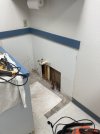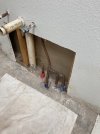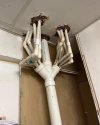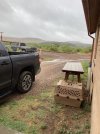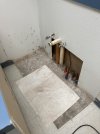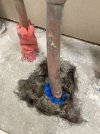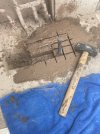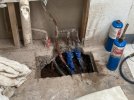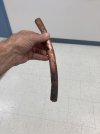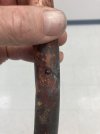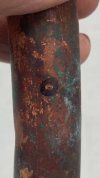Let'sgoflying!
Touchdown! Greaser!
Have a look at this manifold etc in my wall.
2 weeks ago staff came in to a puddle and soaked tiles on both sides of the wall.
They turned the water off till I came back from vacation.
I opened it up and it was damp all over but couldn’t tell which pipe.
I turned it on and it did not leak for 2 days, by the time we looked at it, the water had flowed across all pipes so no way to tell which one.
I *thought* maybe the cold supply so I drilled & cut the concrete around that one.
The water has been on a week now (with the air purged from all lines) and no leak.
Water psi 52.
(Leaks where the copper penetrates the concrete is common in this building; I’ve fixed 4 others through 20 years just like this. The plumber did not seal the plastic sheathing to the pipe with tape, the concrete guys got slop into the sheath, it dried next to the copper and that’s where all these leaks develop.)
The above is just some interesting background that helps explain the history, not particularly a topic for discussion, we’ll I’m not going to respond to that part - I’m looking for suggestions on how to get this leaking again!
2 weeks ago staff came in to a puddle and soaked tiles on both sides of the wall.
They turned the water off till I came back from vacation.
I opened it up and it was damp all over but couldn’t tell which pipe.
I turned it on and it did not leak for 2 days, by the time we looked at it, the water had flowed across all pipes so no way to tell which one.
I *thought* maybe the cold supply so I drilled & cut the concrete around that one.
The water has been on a week now (with the air purged from all lines) and no leak.
Water psi 52.
(Leaks where the copper penetrates the concrete is common in this building; I’ve fixed 4 others through 20 years just like this. The plumber did not seal the plastic sheathing to the pipe with tape, the concrete guys got slop into the sheath, it dried next to the copper and that’s where all these leaks develop.)
The above is just some interesting background that helps explain the history, not particularly a topic for discussion, we’ll I’m not going to respond to that part - I’m looking for suggestions on how to get this leaking again!

